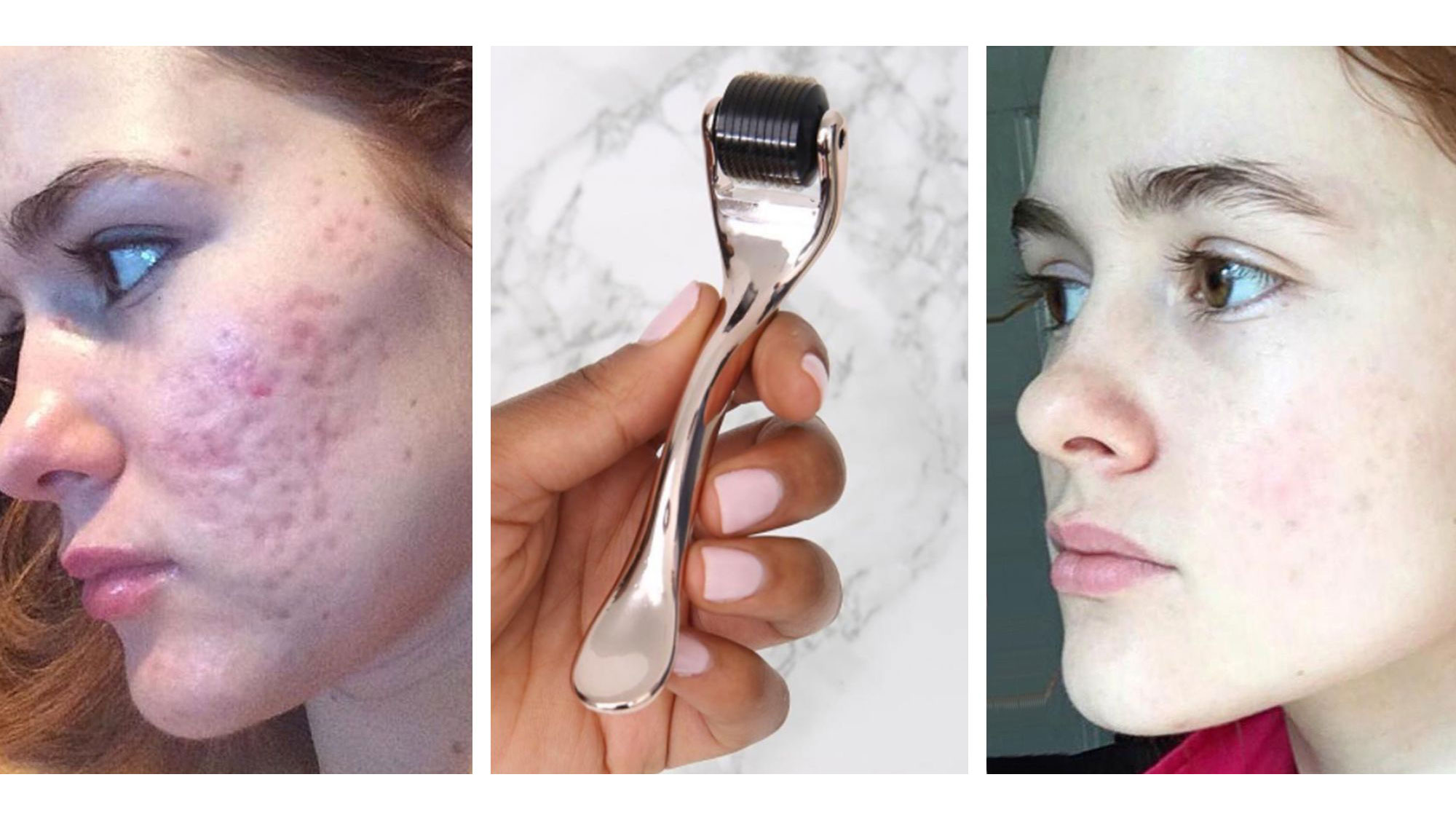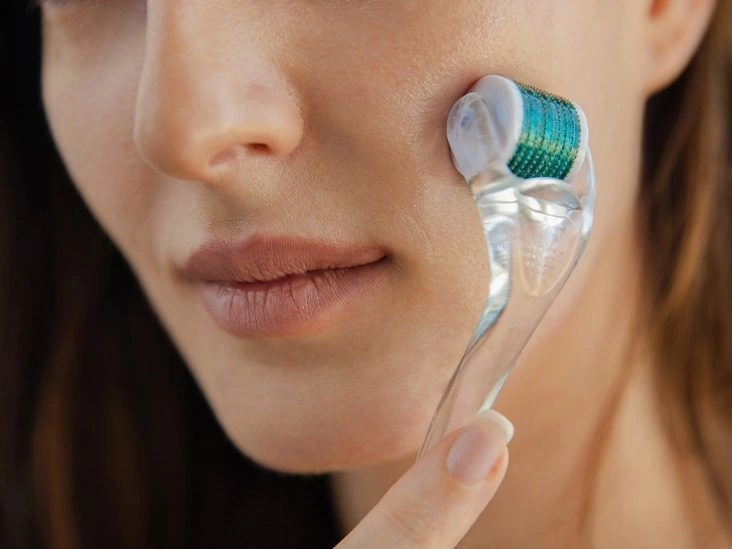Derma rollers can help even out skin texture and lessen pigmentation. For substantial improvements, professional treatments may be required, but at-home rollers can aid skincare products in penetrating the skin.
These days, many treatments that used to be confined to the dermatologist’s clinic can be performed at home.
Microneedling is one of those. The DIY version of this intimidating-sounding facial technique goes by another name: derma rolling.
These handheld tools, featuring a roller studded with rows of tiny needles, are far less expensive and more convenient than seeing a professional.
But do they deliver the same outcomes as clinical microneedling?
What’s the short answer?
To get meaningful benefits from any derma roller, you need to use it correctly so it helps your skin rather than harming it.
Also, keep your expectations realistic.
While at-home derma rollers can produce noticeable changes, you won’t achieve as dramatic results as you would from a professional needling treatment.
What are they used for?
Derma rollers serve a few purposes, but their primary uses are improving pigmentation problems and refining the skin’s surface.
Fine lines, acne scarring, and hyperpigmentation are commonly claimed to be reduced with consistent derma rolling.
In practice, these concerns often respond better to professional microneedling, which employs longer needles than most at-home devices.
For instance, a 2008 study found that four microneedling treatments increased levels of collagen, a protein that firms the skin.
You might not be able to replicate those outcomes at home.
However, derma rollers can help skincare formulations reach deeper layers, enhancing their effectiveness.

How do they work?
Microneedling creates controlled micro-injuries to the skin’s outer layer.
That stimulates the skin’s repair mechanisms, prompting regeneration and production of proteins like collagen and elastin.
At-home derma rollers produce tiny channels with shorter needles.
These micro-pathways allow serums to penetrate further, improving absorption and ideally yielding more visible results.
Does it hurt?
Running hundreds of tiny needles across your face won’t be exactly soothing, but it shouldn’t be intensely painful.
Sensitivity varies depending on your pain threshold.
It’s the longer needles in clinical microneedling that are more likely to cause discomfort.
That’s why reputable practitioners typically numb the skin beforehand.
Are there any side effects or risks to consider?
Derma rolling is minimally invasive, so if you use proper technique with an appropriate serum, significant side effects are unlikely.
If handled incorrectly, however, it “could potentially cause permanent scarring and darkening of the skin,” warns Dr. Saya Obayan, a board-certified dermatologist from Skin Joy Dermatology.
Certain people should avoid derma rolling entirely — those with eczema, psoriasis, or a history of blood clots, for example.
Anyone with conditions that can spread on the face, such as active acne or warts, should consult a clinician before attempting a DIY treatment.
Be cautious if you’re using retinoids, taking Accutane, or have sunburned skin.
Experts recommend pausing retinol about five days before derma rolling to prevent adverse reactions.
For issues like sunburn or inflammation, you can still use a derma roller provided you avoid irritated areas.
How do you pick the right one?
Although longer needles for home use are available, it’s safest to select a derma roller with needle lengths under 0.5 millimeters.
Anything longer increases the risk of skin damage and should be left to professionals.
Do your homework. Purchase from reputable retailers and ensure the device has been properly sterilized prior to delivery.
How do you pick the right serum?
If you pair a serum with your derma roller, pick one whose ingredients will be beneficial if they reach deeper skin layers.
Certain active ingredients can provoke unwanted reactions when driven further into the skin.
Avoid potentially irritating retinol and vitamin C immediately after needling.
Instead, choose serums rich in hyaluronic acid, recommends aesthetician Laura Kearney, owner of Skinsanity.
These help lock in moisture and support the regenerative process that can enhance tone and texture.
How do you do it?
Fortunately, derma rolling isn’t hard to learn. Follow these straightforward steps for a clean, effective session.
Preparation
To minimize bacterial transfer, thoroughly cleanse both your face and the roller. Use gloves if you can, Kearney advises.
It’s best to perform derma rolling in the evening when your skin isn’t exposed to sunlight.
If you’re doing an evening routine, consider double cleansing to remove oil and grime accumulated during the day.
To sanitize the roller, soak it in an alcohol-based solution, then dry it and place it on a clean paper towel.
Process
If you plan to use a serum, apply it before you begin rolling.
The technique involves three directions: vertical, horizontal, and diagonal strokes.
Start by rolling up and down across your forehead, cheeks, and chin, avoiding excessive pressure.
Next, repeat with horizontal passes, then diagonal ones. Limit the session to no more than two minutes.
Keep away from the eye area and be cautious around sensitive spots like the nose and upper lip.
Aftercare
Once you finish, reapply the same serum or use another hydrating or anti-aging product.
Just ensure it does not contain retinols or vitamin C.
Because your skin may be more reactive post-treatment, wearing sunscreen is a smart precaution.
Avoid makeup, hot showers, and strenuous exercise for 24 hours afterward.
Cleanup
Always clean your derma roller after each use.
Disinfect by spraying with 70 percent isopropyl alcohol, advises Dr. Kim Peirano, an acupuncture and Chinese medicine specialist at Lion’s Heart.
She also recommends soaking the roller weekly in hot water with a denture cleansing tablet.
Never share your roller and replace it at least every three months to avoid irritation from blunt needles.
How often should you repeat the process?
Begin with once weekly to gauge how your skin tolerates the needles.
If all goes well, you can step up to two or three times per week.
Just be careful not to exceed two minutes per session.
When will you see results?
The more consistently you roll, the better your chances of observing improvement.
Assess progress after about 6 to 12 weeks of regular derma rolling.
For signs of aging or scarring, it may take several months to notice significant changes, Kearney notes.
Outcomes also depend on age and your skin’s natural elasticity, she adds.
When should you consider in-office microneedling?
Some professionals recommend always seeing a clinician. Dermatologists can assess the skin during treatment and modify settings to avoid harm or injury, says Obayan.
If you want to target fine lines, deep wrinkles, or scars, a visit to the dermatologist is worthwhile.
Their devices can reach up to 3 mm into the skin, which makes visible improvements more probable, Obayan explains.
Kearney adds that clinic microneedling with single-use needles creates more “ideal” micro-injuries that enter perpendicular to the skin’s surface.
By contrast, derma rollers can “be more traumatizing to the skin [by creating] larger and fewer holes as the needle enters at an angle and exits at an angle.”

The bottom line
While dermatologists report multiple benefits from microneedling, much of the evidence stems from small studies.
There’s even less rigorous data on at-home derma rolling — though many users report positive outcomes.
The technique warrants further research, but it’s a reasonable DIY option if you want to enhance your skincare routine.
If you have concerns about potential effects on your skin or need to address more complex problems, consult a dermatologist for guidance.


















Leave a Reply
You must be logged in to post a comment.